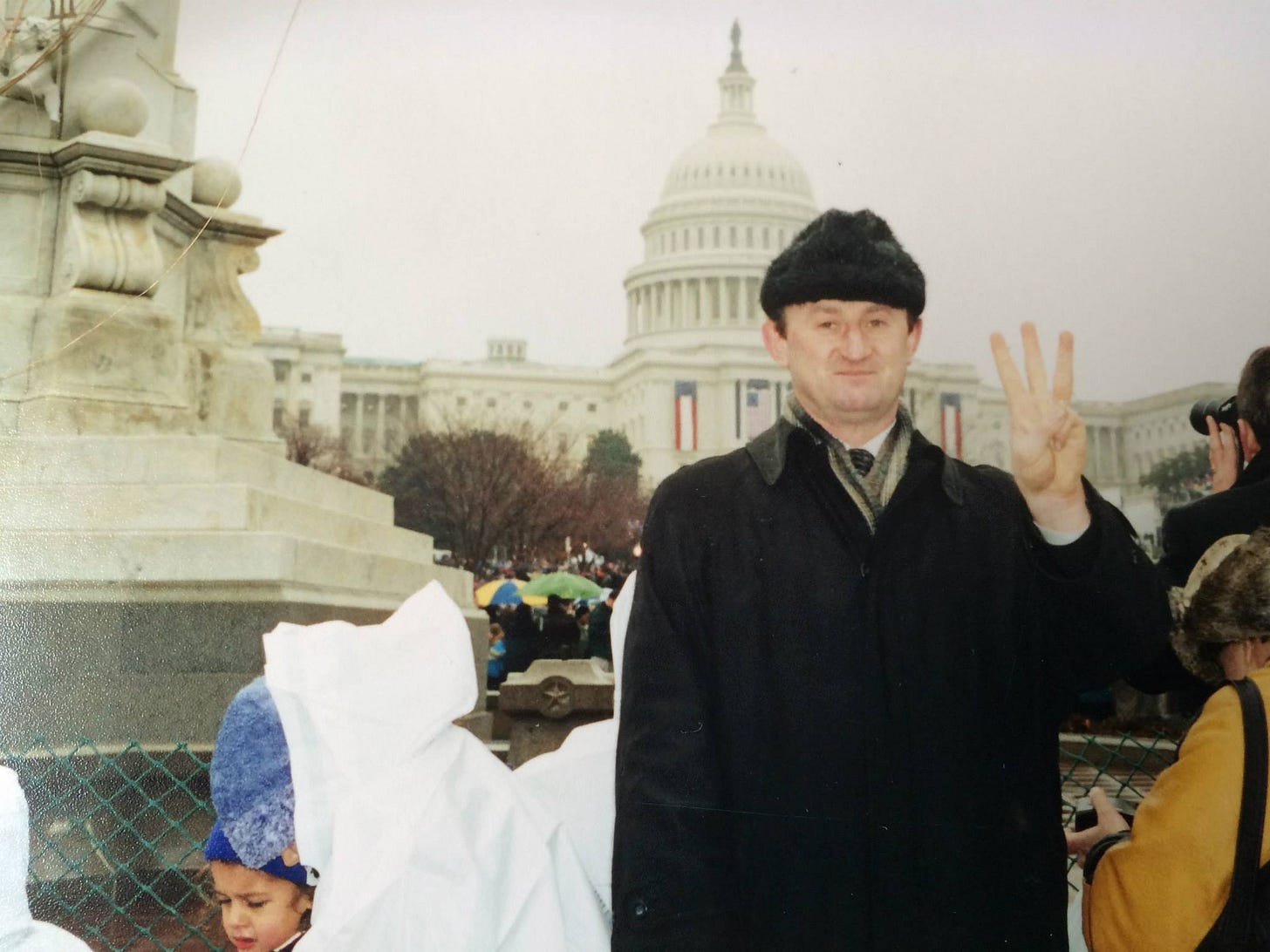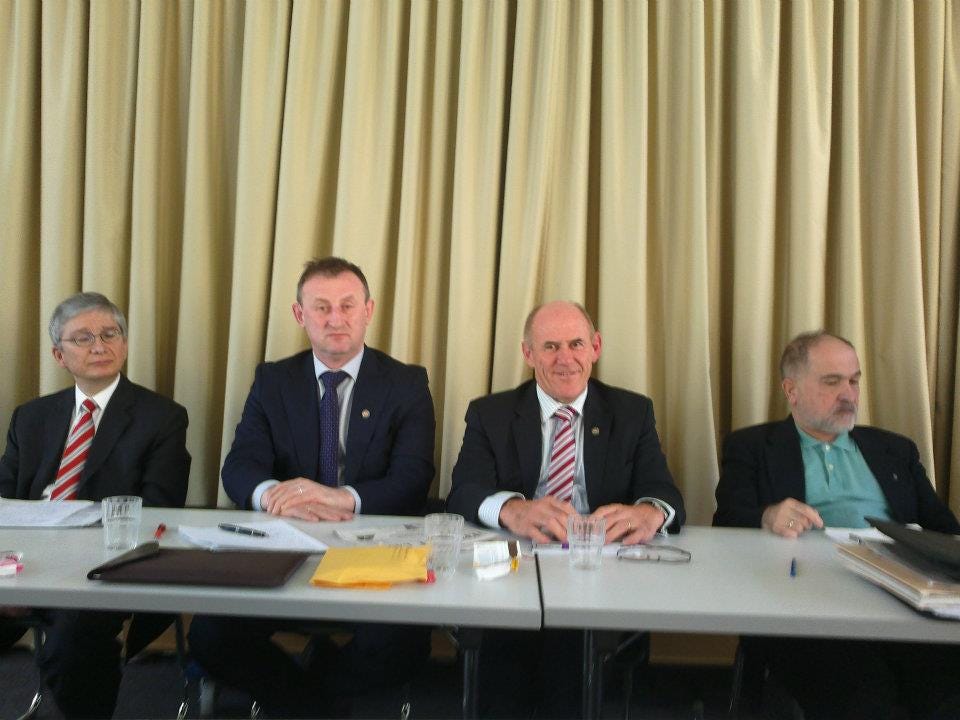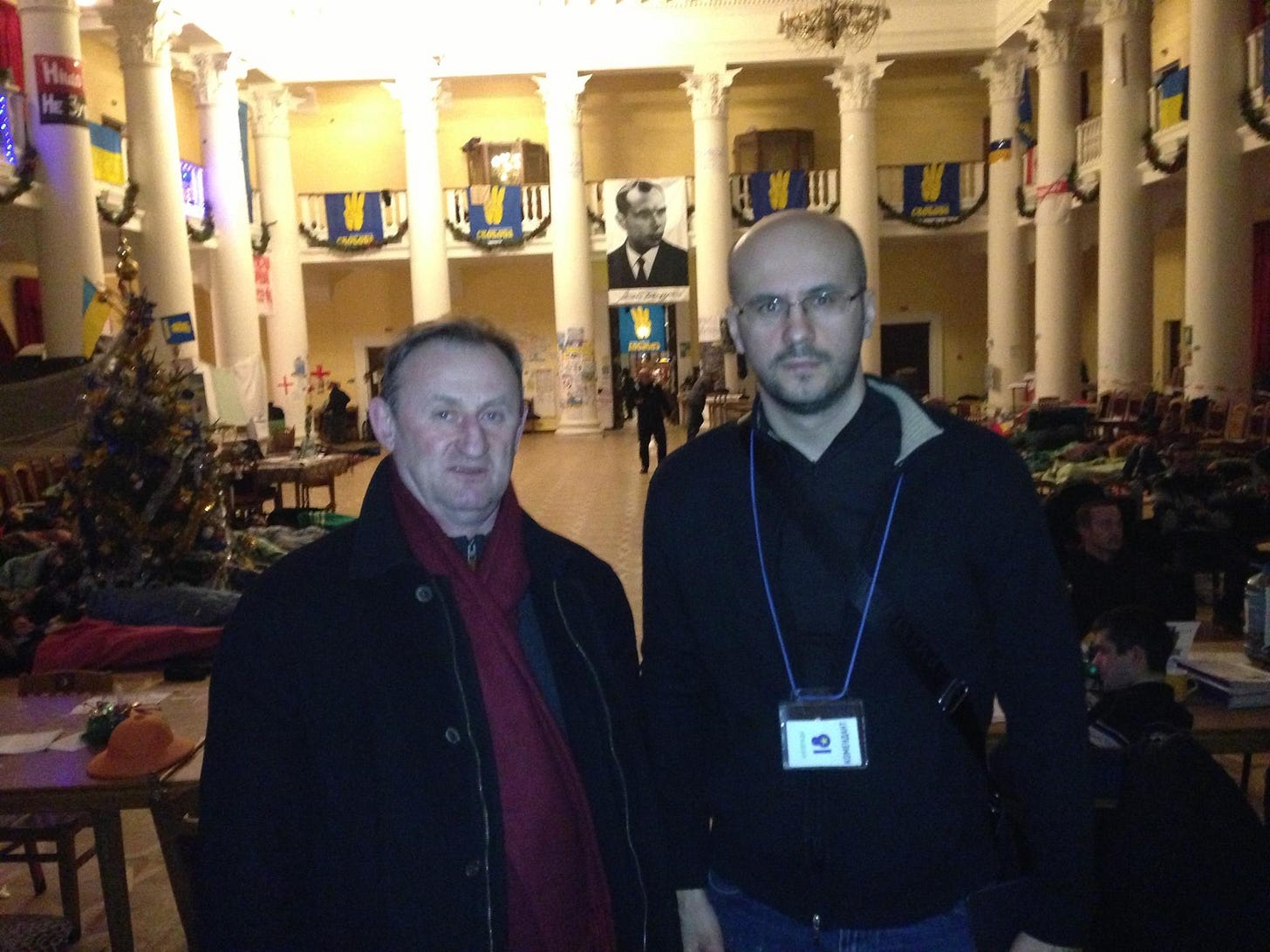Mykhailo Ratushny in Washington DC, most likely in 2000-2001 to attend the inaugural conferences of the OUN-B affiliated Center for US-Ukrainian Relations.In the late-winter of 2000 in Kyiv, a dozen young radicals barged into the headquarters of the Communist Party of Ukraine with an estimated thirty gallons of gasoline, which they started to pour on the floors and even some of the people who worked there. Seizing the building and barricading themselves inside, they hung a large banner from the windows with the words of Mykola Mikhnovsky, the early 20th century ideologue who championed the idea of a homogeneous Greater Ukraine: “One, united, undivided, free and independent Ukraine from the Carpathian Mountains to the Caucasus.”
They threatened to set themselves and the building on fire if their demands weren’t met, “most of which related to purging the government and the state of vestiges of its Soviet past,” according to the Ukrainian Weekly. Among other things, they wanted the government to outlaw the Communist Party and recognize veterans of the Organization of Ukrainian Nationalists (OUN) and Ukrainian Insurgent Army (UPA) as freedom fighters deserving of “appropriate honors and pensions.” These organizations massacred Jews and Poles and collaborated with Nazi Germany during World War II.
After a 13-hour standoff, the group finally surrendered, thanks in part to a negotiator named Mykhailo Ratushny, a Ukrainian politician who was himself in all likelihood a member of the clandestine Stepan Bandera faction of the Organization of Ukrainian Nationalists (OUN-B). At the time, the government conceded nothing to the young extremists, but they were apparently convinced that their terroristic spectacle was successful.
Several years before he authored Ukraine’s controversial decommunization laws, in the spring of 2012, Volodymyr Viatrovych was one of numerous delegates from around the world to arrive in Munich for a two-day gathering of the so-called World Conference of Ukrainian Statehood Organizations (SKUDO). Also known today as the International Council in Support of Ukraine (ICSU), it is the global coordinating body of NGOs affiliated with the OUN-B. Stefan Romaniw of Australia, the leader of the OUN-B since 2009, transparently referred to the event as an international OUN-B conference dedicated to Ukraine’s future.
The conclave was evidently led by Stefan Romaniw and three other individuals: Askold Lozynskyj, the Ukrainian American president of the SKUDO/ICSU, headquartered in New York City; Eugene Czolij, the Ukrainian Canadian president of the diasporan Ukrainian World Congress (UWC), headquartered in Toronto; and Mykhailo Ratushny, the Ukrainian-born president of the Kyiv-based Ukrainian World Coordinating Council (UWCC). Stefan Romaniw, in addition to his duties as the Providnyk of the OUN-B, doubled—nay, tripled—as the General Secretary of the UWC and a vice president of the UWCC.
March 31-April 1, 2012 SKUDO/ICSU/OUN-B conference in Munich. Sitting left to right: Eugene Czolij, Mykhailo Ratushny, Stefan Romaniw, Askold Lozynskyj.Ratushny was elected to his position at the 2011 World Forum of Ukrainians, the UWCC congress which meets every five years. The Coordinating Council and World Forum serve the purpose of uniting Ukrainians with representatives of the so-called western and eastern diaspora, the latter referring to Ukrainians living in other post-Soviet countries. Shortly before he became the new president of the UWCC, Ratushny accused the Russian government of “ethnocide” and “ethnically cleansing” Ukrainians in Russia.
Mykhailo Ratushny has a history of paranoid statements and OUN-B affiliation. After Leonid Kuchma was elected the President of Ukraine in 1994, Ratushny suggested that it may “lead to the full liquidation of the Ukrainian state”—a Russian takeover of the newly independent country. Also that year, Ratushny was one of a handful of members of the OUN-B’s radical right political party, the Congress of Ukrainian Nationalists (CUN), to be elected to Parliament. Voters sent him back to the Verkhovna Rada in 1998, by which time he had become a high-level member of the CUN.
Two years later, after the disappearance and murder of journalist Georgiy Gongadze, which set off anti-Kuchma protests in Ukraine, Ratushny “strongly suggested” that the scandal was somehow orchestrated by Moscow. In the meantime, he had co-founded the right-wing Ukrainian People’s Party (UNP), but this doesn’t mean that Ratushny broke with the OUN-B. The Banderites opted not to put all of their eggs in one CUN basket. Ivan Gavdyda, deputy leader of the OUN-B (2000-2003), also joined the new party.
At the time that Gongadze was abducted and killed, months after the standoff at the Communist Party headquarters in Kyiv, Mykhailo Ratushny was in Washington DC. Invited to speak at the first-ever conference (“Ukraine’s Quest for Mature Nation Statehood”) organized by the Center for US-Ukrainian Relations (CUSUR), which itself is tied to the OUN-B and is an official partner of the SKUDO/ICSU, he spent several months in the United States. The conference took place in September, soon before the 2000 U.S. presidential election. Introduced by the late Nadia Diuk, a prominent person in the National Endowment for Democracy, Ratushny spoke about the collapse of the Soviet Union and concluded his speech with a warning that “communist revanchists … remain a force to be reckoned with.”
The evening that CUSUR’s inaugural conference wrapped up, Ratushny found himself in the Hart Office Building of the U.S. Senate as one of two Ukrainian government officials to attend a belated commemoration of the ninth anniversary of Ukraine’s independence. The Congressional reception was co-sponsored by the Congressional Ukrainian Caucus (CUC), which was founded in 1997 on the initiative of the Banderite-dominated Ukrainian Congress Committee of America (UCCA). From 1998 to 2000, longtime OUN-B operative Askold Lozynskyj was the president of both the UCCA (1992-2000) and the Ukrainian World Congress (1998-2008). At both the CUSUR conference and the Congressional reception, CUC co-founder U.S. Representative Sander Levin (D-MI) was introduced by a friend of his, Borys Potapenko, another OUN-B member who is today the president of the SKUDO/ICSU.
Mykhailo Ratushny stuck around long enough to be in Washington for the inauguration of George W. Bush. Three days later, he spoke at a forum at the International Republican Institute, the “democracy promotion” arm of the Republican Party, during which Ratushny made his comments speculating at the hidden hand of Moscow behind the “current scandal dealing with accusations of presidential complicity in the disappearance and possible murder” of Georgiy Gongadze. Later that year, Ratushny spoke at the second annual CUSUR conference, following speeches by CUC co-chairs Marcy Kaptur (D-NY) and Bob Schaffer (R-CO). Fast forward a decade, he was elected the president of the Ukrainian World Coordinating Council, and it seems became the first Banderite to take the helm of the international organization.
Mykhailo Rutushny and U.S. Representative Marcy Kaptur at the 21st Congress of Ukrainians in America, September 2012. In late September 2012, several months after the SKUDO/ICSU/OUN-B conference in Munich, Mykhailo Ratushny returned to the United States to attend the 21st Congress of Ukrainians in America, which took place in Yonkers, New York. He participated in a panel moderated by Roksolana Lozynskyj, chair of the UCCA’s External Affairs Committee and wife of SKUDO/ICSU president Askold Lozynskyj. His sister is also a member of the UCCA board of directors. Last summer, an important longtime member of the UCCA secretly submitted a whistleblower complaint to the New York State Attorney General’s office about the Congress Committee’s “irregularities and fraudulent activities,” “egregious improprieties,” and “many conflict of interest situations especially within the board of directors.”
The “Euromaidan” protest movement—what came to be called the “Revolution of Dignity”—began the night of November 21, 2013 in response to President Viktor Yanukovych’s decision not to sign an association agreement with the European Union, but the protests grew much larger after police violently dispersed those who had gathered on Kyiv’s Independence Square on the night of November 30. Earlier that day, Ratushny posed for a photo with his UWCC deputy (OUN-B leader Stefan Romaniw) as well as Marko and Ulana Suprun, an influential diaspora nationalist couple who are both likely members of the OUN-B. The Supruns later founded “Patriot Defense,” an NGO and initiative of the Ukrainian World Congress that would soon enough share an address with the OUN-B headquarters building in Kyiv.
A few months before the protests began, Mykhailo Ratushny appeared on stage at the opening of the 10th Ukrainian World Congress in Lviv with the trio of parliamentary opposition leaders, Arseniy Yatsenyuk, Vitali Klitschko, and Oleh Tyahnybok. The latter is the head of the neo-fascist Svoboda party, formerly known as the “Social National Party of Ukraine” (SNPU), at which time it sported a wolfsangel swastika. Ratushny met with Svoboda’s Ruslan Koshulinskiy earlier that year. During the month of December, Mykhailo Ratushny separately met with Stepan Bandera’s Canadian grandson and rubbed shoulders with the Canadian Foreign Minister. As the protests turned more violent, the far-right took on an increasingly prominent role.
Mykhailo Ratushny and Serhiy Rudyk, January 2014.On January 17, 2014, the day that President Yanukovych signed the “dictatorship laws,” Mykhailo Ratushny posted the above photo on Facebook, which he took with the “commandant of the revolutionary Kyiv City Council,” Svoboda’s Serhiy Rudyk. It appears that this might have been the start of a fruitful working relationship between the two. (More about this later.) The Svoboda-occupied City Council soon hosted the first “Bandera Readings,” at which Romaniw, Tyahnybok, and others spoke. It has since become an annual event that seems to serve the purpose of promoting far-right unity. In the coming weeks leading up to Yanukovych’s decision to flee Ukraine, Ratushny also took a photo together with Romaniw and Tyahnybok, and met with Maidan Self Defense commandant Andriy Parubiy, who co-founded the neo-Nazi SNPU with Tyahnybok.
Later that year, a month after the signing of the first Minsk Protocol which implemented a ceasefire to the war in eastern Ukraine, Ratushny paid a visit to members of the notoriously neo-fascist Right Sector’s Volunteer Ukrainian Corps and took some photos with RS leader Dmytro Yarosh. They probably knew each other back in the 1990s, when Yarosh was part of the Stepan Bandera All-Ukrainian Organization “Tryzub,” originally created on behalf of the OUN-B as the paramilitary arm of the Congress of Ukrainian Nationalists.
On New Year’s Day in 2015 and 2016, Mykhailo Ratushny participated in daunting torchlit marches in Kyiv to commemorate Stepan Bandera’s birthday. As always, there were many Svoboda flags in sight. In 2016, he took a photo of Ulana Suprun at the march. In the meantime, in the summer of 2015, Ratushny visited the neo-Nazi Azov Battalion, which like the late SNPU uses the wolfsangel swastika.
That autumn, he made the trip to Munich for the 56th anniversary of Bandera’s assassination by the KGB, and made an appearance in court to show support for Svoboda’s Yuriy Syrotiuk, the chief organizer of the Bandera Readings. Syrotiuk was arrested for his participation in a riot outside of Ukraine’s parliament that killed three police officers; someone threw a grenade. In a matter of days, Ratushny was back in Washington for the unveiling of its Holodomor memorial, where he was pictured with Stefan Romaniw, Borys Potapenko, U.S. Representative Sander Levin, and Walter Zaryckyj, who is the executive director of the Center for US-Ukrainian Relations and allegedly the U.S. leader of the OUN-B. (As I’m writing this, I see that Zaryckyj has sent me an email suggesting I am a Russian agent and Moss Robeson is an alias.) One can barely see a couple of Svoboda flags waving in the background of the picture of Romaniw, Zaryckyj, and Ratushny.
In April 2016, Mykhailo Ratushny traveled to Stockholm with Serhiy Rudyk, the month the latter made the switch to the ruling Petro Poroshenko Bloc and was consequently condemned by Svoboda. A year later, they traveled to Romania. It seems reasonable to speculate that Rudyk may have joined the Ukrainian World Coordinating Council, considering by this point that Olexandr Ushynskyi, who fought with Right Sector in the Donbas, was a member of the UWCC presidium. In September 2016, soon after Ratushny and Romaniw were re-elected to their positions in the UWCC, Ratushny met with the neo-Nazi Azov movement’s Oleksandr Chupryniuk.
In early 2017, leaders of the Svoboda party, Right Sector, and the Azov’s political wing, the National Corps, signed a “National Manifesto” in Kyiv, supported by the neo-Nazi “C14,” the Congress of Ukrainian Nationalists, and the Melnyk faction of the Organization of Ukrainian Nationalists (OUN-M). That December, the leaders of those far-right groups spoke at the third-ever Right Sector congress. So did Mykhailo Ratushny, on behalf of the UWCC and the Ukrainian diaspora, which he said supported Right Sector and provided it assistance via his organization.
Mykhailo Ratushny took his flirtation with far-right extremists to the next level in January 2019, when he attended a National Corps congress. “In what’s illustrative of the Azov’s growth,” journalist Oleksiy Kuzmenko tells us, the delegates “filled Kyiv’s spacious Sports Palace.” Ratushny was sitting in the third or fourth row next to Pavlo Osnovenko; they were also standing next to each other when Ratushny took a photo with members of the Azov Battalion in the summer of 2015. Perhaps Osnovenko is Azov’s liaison to the UWCC. In one of his featured photos on Facebook, Osnovenko is standing next to someone wearing a “White Pride World Wide” t-shirt with the “14 words.” The same month as the National Corps convention, Azov’s “street wing,” the National Militia, made an Instagram post in which it said, “We are the driving Force that will tear down this rotten system, and impose the real Ukrainian order.”
Ratushny posted several photos of the event on Facebook, including a picture of a silver ring with a wolfsangel swastika—apparently the highest honor of the National Corps, which he received in recognition of the support that the UWCC (i.e. the Ukrainian diaspora) has provided to the Azov Battalion.





Two months later, Mykhailo Ratushny was photographed with the OUN-B’s Askold Lozynskyj and his family at a movie premiere in Kyiv.



“Is that Askold in the photo?” commented the longtime Ukrainian Weekly columnist Myron Kuropas, 88, on Facebook. When Lozynskyj took over the Ukrainian World Congress twenty-odd years ago, Kuropas urged Ukrainian Americans to give the divisive OUN-B member a second chance, whom he described as “someone I have known (and disagreed with) for decades. He is bright, brash, articulate (often given to demagoguery), thoroughly bilingual and dynamic. I have watched him mature over the years from a firebrand Banderite to a more nuanced Banderite.” Lozynskyj grew up getting into gang fights in Manhattan’s Little Ukraine, and his appetite for conflict has not abated. He also has a record of anti-Semitism. Earlier this year, Kuropas conceded that he was wrong. “In retrospect I don’t see Askold maturing for the better politically. He seems to still follow Bandera’s dictum that ‘those who are not with us are against us.’ He still seems to push for OUN-B domination of the Ukrainian American community.”
In the coming months, the Ukrainian World Coordinating Council president was also photographed with far-right leaders from Svoboda, Tryzub, the Congress of Ukrainian Nationalists, the OUN-M, and the UNA-UNSO. He has participated in “No Capitulation!” protests and is clearly a strong supporter of the so-called “Capitulation Resistance Movement.” As I have already written, the latter’s launch was spearheaded by an OUN-B affiliated NGO, “Free People,” which is a member organization of the SKUDO/ICSU. Ratushny attended a “Capitulation Resistance Movement” forum in November 2019 at which SKUDO/ICSU president Borys Potapenko and OUN-B deputy leader (at least as of 2013-14) Oleh Medunitsya were sitting in the front row, along with the UWCC leader.
Mykhailo Ratushny has periodically shown up to anti-“capitulation” / “revanche” protests against the current Ukrainian government that risk being co-opted by the far-right and the Azov movement in particular if they gain momentum. But then again, Ratushny probably wouldn’t mind. Perhaps the Coordinating Council president imagines such a scenario would just give him another opportunity to save the day and negotiate with the extremists when they threaten to burn everything to the ground.






